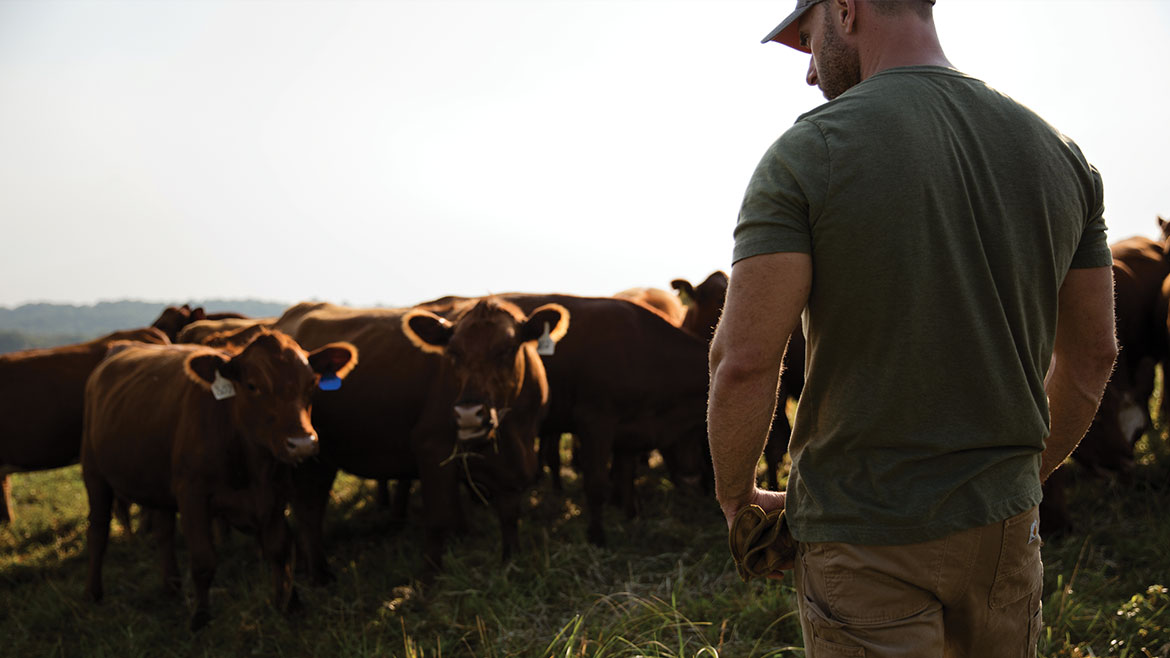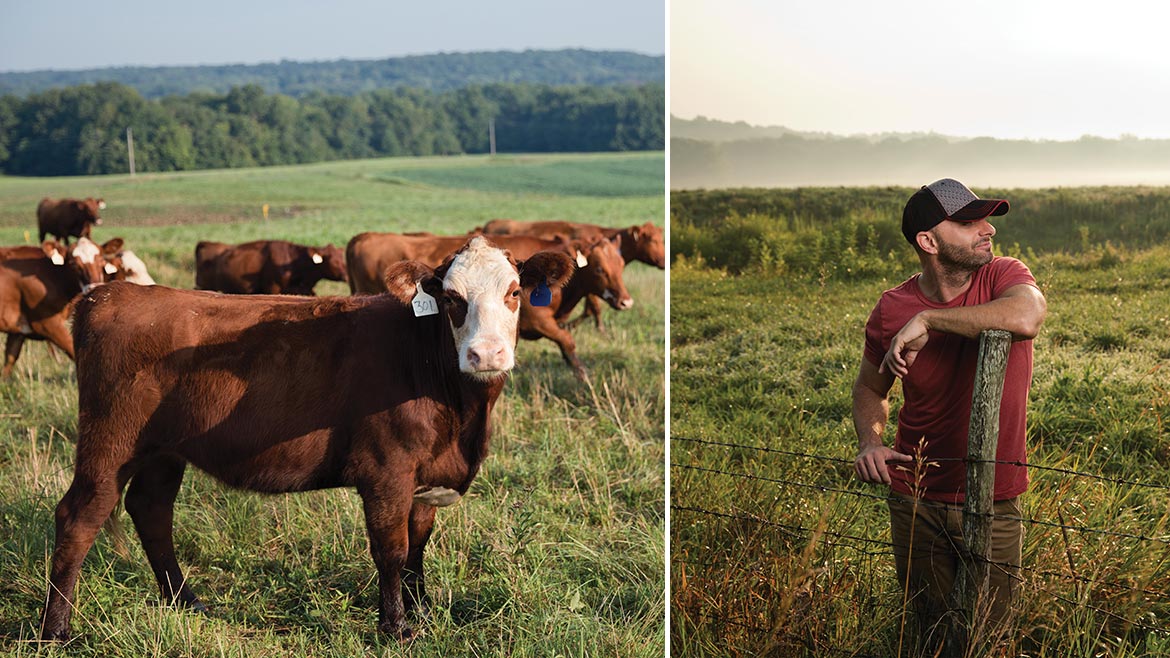
It was a weird transition for Doug Nichols. From banking to beef.
Upon completion of his ag business degree at MU in 2001, Nichols left Mid-Missouri and moved to St. Louis, getting his start in a transaction-based financial advisory firm whose unofficial motto was “smile as you dial.” He didn’t like it. Quickly realizing that “smile as you dial” was definitely not the customer-first approach he craved, he transitioned to retail banking while earning his master’s degree, eventually working his way into a high-end boutique firm with an emphasis on client service.
Nichols remained nimble throughout the financial crisis in the late aughts — he developed his own consulting business and maintained it for years — but the passion never fully developed; he found himself much more excited about his family expanding their farm back home in Marshall, Missouri. A close friend finally told him: “Quit putting a square peg in a round hole. All you talk about is that farm in Marshall.”
“I realized, I guess I’m done with it,” Nichols says, “and I told myself: ‘Just accept it. Just accept it, Doug. You’re trying to fool somebody or yourself.’ It was hard leaving the financial industry in my mid-30s, when you don’t know anybody in ag. But when you’re on LinkedIn, you know people who know people, so I started networking and talking. They told me that if I’ve already managed $80 million, surely I could manage a couple cows.”
Nichols returned home in 2015 and launched Cloverleaf Farms, a grass-fed, hormone-free, humanely-raised beef operation on 200 acres. He built a herd of 110 South Poll cattle, bred to thrive on an exclusively grain-free diet to maintain a pure product — and it resonated.
Customers have already placed orders in the increments many rural consumers are familiar with: beef by the “whole,” “half,” or “quarter.” The next step will be to provide portions for those with more limited freezer space: the mainstream beef eaters.
Nichols has overcome many of the common hurdles facing startup operations in their first few years. He got the land, he secured the financing, and he already sold pre-purchased product through next year, but developing consistent distribution channels will be key for continued growth. It’s a startup problem, but it’s also been a longtime farmer problem.
With so many barriers to entry for new farmers, he hopes a coordinated effort could mean a more streamlined trip to market. To address the issue, Cloverleaf Farms is seeking to build a co-op with other area farms to meet supply needs and provide continuous inventory. Nichols is committed to maintaining quality while helping other small operations; he hopes to partner with grocers or restaurants by bringing producers together to guarantee a consistent supply of product. His plan is still in the building stages, but he envisions a way to consolidate transportation and other costs while utilizing his marketing skills to enhance brand recognition.
Nichols’ career in finance may have prepared him for life at Cloverleaf Farms more than one would think. Small farming in Mid-Missouri is as much about business acumen as it is about raising cattle or crops.
Risk and more risk
“I don’t have the luxury of crop insurance,” says Liz Graznak of Happy Hollow Farms, one of only a handful of certified organic farms in the area. Not only does she do without the subsidies enjoyed by row crop farmers (as do many other small producers), but she also has to comply with certified organic standards, which require more labor-intensive methods and the absence of conventional pesticides and other agricultural chemicals.
Carrying the full burden of risk, Graznak’s operation is highly calculated and diversified out of necessity. She sells produce every weekend at the Columbia Farmers Market; operates a Community Supported Agriculture, or CSA, program serving roughly 60 families; supplies produce to Natural Grocers at least 40 weeks per year; and caters to restaurant clients Sycamore, Main Squeeze, and Barred Owl on a regular basis.
Happy Hollow Farms grows around 100 varieties of vegetables on limited acreage, which means its systems cannot be mechanized and the crops need hands-on maintenance and harvesting. Developing several avenues for sales is what it takes for Graznak to make a living, sustaining her household and her seven employees. “This is where scale makes a huge difference,” she says.
More and more farmers find that a single route to market isn’t enough to keep afloat. While many smaller producers sell to consumers seeking local goods via a farmers market booth, selling exclusively at the markets on weekends is a hard and sporadic way to make a wage. One rainy Saturday with a small crowd could knock down attendance from the typical count — 3,000 shoppers during the height of the season — to one-third of that, according to the Columbia Farmers Market manager, Corrina Smith. While the proposed new Agriculture Park’s enclosed pavilion (see story, page 54) is intended to solve some of those headaches for existing vendors, limited booth space for the market means prospective sellers are turned away every year.
Hence the need for something new.
Innovative Methods
Farmers markets, CSA programs, and restaurant partnerships are all viable ways to sell directly to the consumer. But they cater to buyers who are already well-versed in the value of locally sourced food (for more on locally sourced food, see note at bottom) and are enthusiastically willing to pay for it. In these distribution channels, the buyer pursues the seller, seeking out a premium product.
So how do producers reach the larger market? How do they find consumers who can’t justify an extra trip beyond the supermarket (or who opt for grocery delivery), where they also may need to purchase non-local items like a pineapple, frozen shrimp, and a 12-pack of diet soda? Many farmers want a way to get their products in front of such buyers — the ones who will only purchase locally when it’s convenient — which means selling wholesale to grocers.

Two local success stories who have weathered through to establishment are the pork producers who make up the non-profit Patchwork Farms, and the famous flaxseed-fed beef operation, Show-Me Farms. But producing a steady, adequate supply that can sustain a grocery store is one of the highest hurdles for any still-emerging farm-to-table producer. West Broadway Hy-Vee’s produce manager, Dan Elston, cites this as the big challenge for local vendors, as many struggle to keep up with demand.
Elston and Sara Bartow, the health market manager, have quietly made Columbia’s original Hy-Vee a key player in providing local producers access to the grocer’s shelves. Hy-Vee’s company structure gives inventory and purchasing control to individual managers rather than corporate directors, so local stores have an uncommon amount of buying flexibility. Hy-Vee can provide the UPC label, suggest pricing if requested, and doesn’t require the liability policies, corporate approvals, or vendor badges that many other grocers insist on.
While carrying roughly 75 to 100 products made by local vendors in town, the store makes a concerted effort to build partnerships whenever they can, but Elston recognizes that “a big problem for local producers is over-promising and under-delivering.”
With limited players, any hiccup can mean a crippling disruption to established supply chains. Not so long ago, several local meat producers were processing through Jennings Premium Meats in New Franklin, so the temporary closing of that butcher shop caused chaos as several small farmers scrambled to find new packers. Those producers had no ground beef in the grocers’ cases for a couple weeks as the products were rerouted to other shops. Consumers, naturally, aren’t willing to wait and make other buying choices in the absence of the brand they prefer.
Even growers who have been in the business for years tire of the headaches from regulations, distribution routes, and economies of scale.
“Sometimes, they just close up shop,” Elston says. He had one watermelon supplier who switched to growing soy beans because it was more profitable. Bartow remembers an egg farmer with a strong local following who completely quit the business, saying it wasn’t profitable enough, in spite of her brand’s popularity and successful marketing.
To help maintain a consistent supply on its most perishable goods, Hy-Vee buys the lion’s share of their local produce from the Clark Produce Auction, a wholesaler and avenue for farmers to sell products that are retail-ready. Many of their sellers bring surplus goods left over from stands at farmers markets, minimizing waste and providing an additional sales point. The process carries its own imperfections with consistent deliveries and communication — Clark is an Amish market, so phone orders aren’t always an option — but these kinds of wholesalers serve a critical role in connecting buyers and sellers, according to MU Assistant Professor Mary Hendrickson, who teaches a class on community food systems.
Hendrickson brings her students to a session at Hy-Vee each October to see community food distribution in action. She considers Hy-Vee’s system a success story, but she says it’s still a huge challenge for farmers to bridge gaps. “There are cost issues in food distribution systems, because there’s not a lot of wiggle room in food,” Hendrickson says. “There isn’t very good standardization in labeling, for instance, so small farmers can be put in a competitive disadvantage. It comes down to competition and cost.”
Finding a successful system with both aggregation and distribution is a tough nut to crack, Hendrickson says. And that’s why food hubs have attracted the latest industry buzz.
The Hubbub on Food Hubs
The federal government offers grant opportunities for these wholesale intermediaries, which are intended to boost the viability of small and medium-sized farms to sell cooperatively. They’re recognized by the USDA as “a centrally located facility with a business management structure facilitating the aggregation, storage, processing, distribution and/or marketing of locally/regionally produced food products.” Food hubs are designed to provide farmers with the service of sorting, packing, and grading products at a pricing level consumers can afford, thus eliminating the farmers’ stresses of consistent supply and sales hawking.
Root Cellar, in Columbia, is the only USDA-registered food hub in Mid-Missouri, serving roughly 400 participating families as customers. They source from a range of different farms and producers to offer weekly food boxes providing a variety of goods in addition to their in-store retail offerings and restaurant clients. Owner Jake Davis says he isn’t necessarily against wholesaling, but he sees value lost to the middle-man under such a business structure. Through food hubs, farmers can sell more directly to the consumer.
Davis also sees opportunities for change in distribution, since “small-scale distribution and processing has been lost over the generations,” he says. In particular, he pointed to a significant need for processing and value-adding surplus items — take Missouri’s tomatoes, for example. Many times, an excess of such perishable crops, without any other distribution or selling point, are left in the field when they could have been made into marinara or other canned goods with an extended shelf life. While Root Cellar does do some quick-freezing, Davis says, they’d love to see others take that off their hands.
The small farming industry doesn’t lend itself to catch-all solutions that would serve every local farmer — when considering all the variances in products, shelf-life, operational scale, and regulations, the challenges are too fickle to solve all at once. But with the support of the Mid-Missouri community and the innovation of entrepreneurs, strides are being made to help startups gain their footing. And small farms, like Doug Nichols’, can be the perfect place to think up big ideas, like the Cloverleaf co-op.

“There has to be an opportunity,” Nichols says. “What if a Mid-Missouri co-op was here and gave these people an opportunity to sell to the co-op instead of sit at the farmers’ market? Then you’ve got the power to go [from there] to Hy-Vee. I think it’s huge.”
*******************
- So what constitutes a “local” grower?
Hy-Vee defines “locally grown” as being within 200 miles of the specific store, but other grocers have a looser definition and ship goods from states away. Often, it’s left to the consumer to inquire about the sourcing of products on the shelves; to Liz Graznak, owner of Happy Hollow Farms, local means within 100 miles. To sell at the Columbia Farmers Market, vendors must be within 50 miles.
Across the country, a variety of food hubs have sprouted, but they remain more prevalent on the coasts. Mary Hendrickson, an MU professor who teaches a class on community food systems, says such entities have yet to be embraced as readily in the Midwest and Southeast regions. Still, a more robust wholesale model could be helpful for Mid-Missouri’s economy, its consumers, and its farmers.


